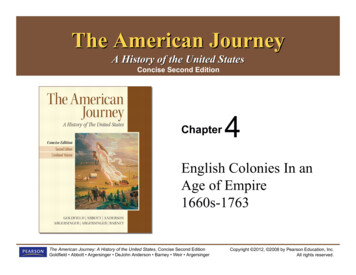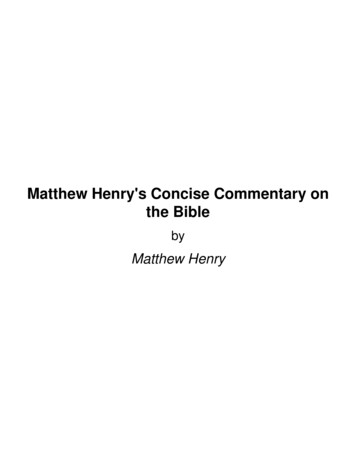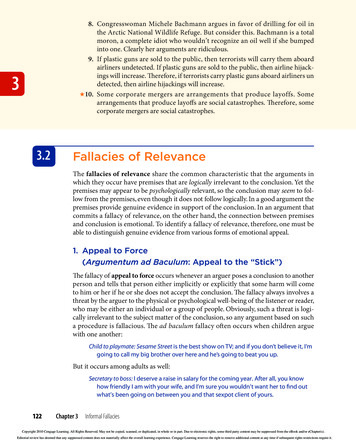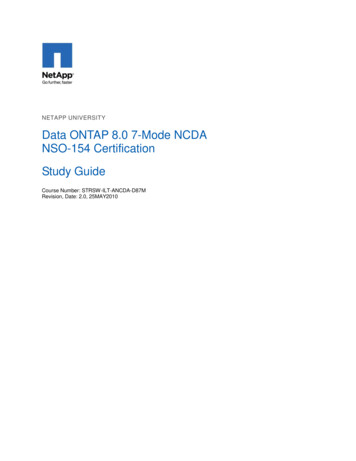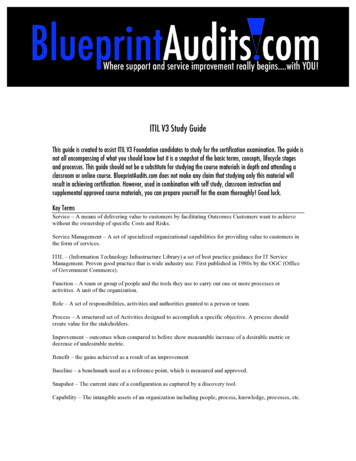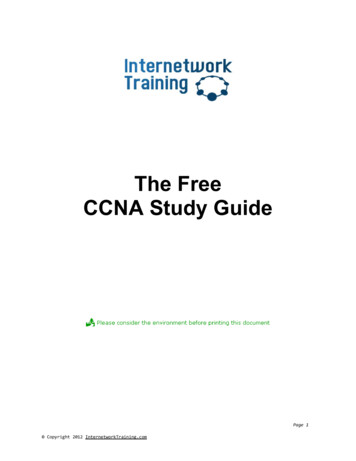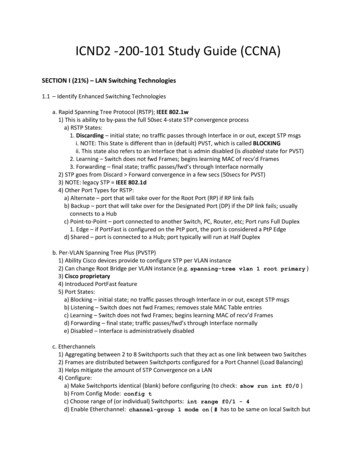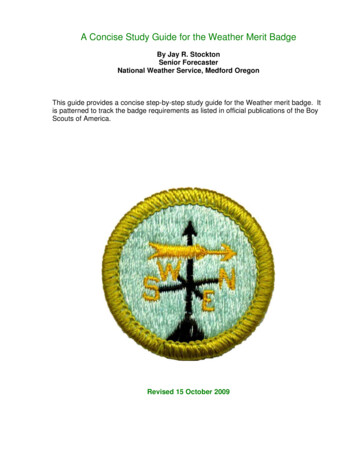
Transcription
A Concise Study Guide for the Weather Merit BadgeBy Jay R. StocktonSenior ForecasterNational Weather Service, Medford OregonThis guide provides a concise step-by-step study guide for the Weather merit badge. Itis patterned to track the badge requirements as listed in official publications of the BoyScouts of America.Revised 15 October 2009
Requirement 1: Define Meteorology. Explain what weather is and what climate is.Discuss how the weather affects farmers, sailors, aviators, and the outdoorconstruction industry. Tell why weather forecasts are important to each of thesegroups.Let’s start with the definition of meteorology. Meteorology is the study of theatmosphere and its weather. It is not limited to the atmosphere of the earth.Meteorologists study other planets and even atmospheric conditions around stars and indeep space.The word meteorology is derived from two greek words. The first is "meteoron", whichmeans “thing in the air”. The second is “logos”, which in this context means knowledgeor discussion. So meteorology literally means “knowledge (or discussion) of things inthe air”.There are many different kinds of “meteorons”. A lithometeor is made of particles fromthe ground, such as flying dust and smoke. A hydrometeor is one composed of water,such as a raindrop or snowflake. Electrometeors include lightning and the aurora.Photometeors include rainbows, fogbows, halos, and mirages. Now let’s talk about weather and climate. Weather consists of the short term (secondsto days) variations in the atmosphere with respect to heat or cold, wetness or dryness,calmness or storminess, clearness or cloudiness. Climate is defined as the averagecourse or condition of the weather at a given location, usually over a period of years, asexhibited by temperature, wind velocity, and precipitation.Another way to say this is that climate is what you expect, weather is what you get.
Weather can affect people in many different ways. Farmers are greatly affected by theamount and type of precipitation their crops receive during the growing season. Cropscan be damaged by too little or too much rain or by the timing of the rain. Hailstonesfrom thunderstorms can damage fruit. Strong winds from any number of sources canbreak plants or affect the spraying of pesticides. Frosts and freezes can also damageor kill plants.Sailors are especially vulnerable to weather as they usually cannot find shelter quickly.Winds are the most important factor as strong winds can generate rough seas,especially if they blow over a long expanse of water upstream from the boat. Sailorscan get lost in fog, and freezing spray during cold conditions can damage and evencapsize a boat.Aviators are primarily concerned about three things: Icing, turbulence, and low ceilingsand visibilities. Icing is caused by liquid water collecting and then freezing on theaircraft. This makes the airplane heavier, less aerodynamic, and harder to handle.Turbulence, primarily due to strong horizontal and vertical winds, can jostle the airplane,causing difficulty in handling as well as possibly damaging the plane. Low ceilings canobscure terrain and low visibilities make it difficult for the pilot to see where he is going.The outdoor construction industry is mostly concerned about rain, because certain jobscan only be done in dry weather. Other concerns include strong winds, which candamage structures that are not completely built yet, and temperatures, which can affectthe ability to do certain tasks. Of course severe weather, like tornadoes and hurricanes,can destroy all sorts of structures.
Requirement 2: Name five dangerous weather-related conditions. Give the safetyrules for each when outdoors and explain the difference between a severeweather watch and a warning. Discuss the safety rules with your family.There are many dangerous weather related conditions. In this discussion, we will coverthe five listed in the Weather Merit Badge Series book. The scout may select otherconditions not listed here.Winter Storms: These can include snow/ice storms, blizzards, and extreme coldcombined with strong winds.Winter Storm Safety Rules: Stay dry, cover all exposed parts of your body, and avoidoverexertion. Seek protection from the wind and build a fire if you can. If you are in acar, stay with the car, tie a brightly colored ribbon to the antenna, clear the exhaustpipe, and run the heater around 10 minutes an hour.Thunderstorms: These are large cumulonimbus clouds with lightning and thunder.They may contain heavy rain, strong winds, and large hail.Thunderstorm Safety Rules: Seek shelter such as a house or car. If that is notpossible, become the smallest target that you can. Try crouching in a low area, butavoid gullies and stream beds. Stay away from open areas and tall objects such astrees or power poles. Stay away from water, metallic objects, and anything that useselectricity.Flash Floods and Floods: These occur when creeks or rivers overflow their banks, orwhen urban drainage systems fail. Flash Floods generally occur due to intense rainfallover a small area or from a dam break, and the waters rise and fall rapidly. The flashflood occurs within six hours of the event that caused it. Floods generally occur onlarger rivers and cover a wider area. Flood events can take days to rise, crest, andsubside.Flood Safety Rules: Get to higher ground. Do not camp in gullies or near streambeds. Do not drive into water.
Tornadoes: These are violently rotating columns of air, in contact with the ground, thatdescend from cumulonimbus clouds. They are often (but not always) visible as a funnelcloud. Winds near a tornado can be as high as 300 mph. Most tornadoes are lessthan a few hundred yards wide, last for a few minutes, and trace a path of a mile or less.However, there have been tornadoes that were a mile wide, last for an hour or more,and produce damage paths more than 100 miles long.Tornado Safety Rules: The main danger from tornadoes is flying debris. Thereforethe best option is to get to a place that provides as much protection as possible. If youhave a basement, seek refuge there and get under a large object, such as a workbench.If you have no basement, the best place to go is a center room in the house, especiallya bathroom, where the plumbing reinforces the walls. For the best possible protection,get into the bathtub with a mattress over your body. Stay away from windows. Ifcaught in the open, find a low place that is not flooded, lie face down and cover yourhead.Hurricanes: A hurricane is a large tropical cyclone with sustained winds exceeding 74mph that occurs in the Atlantic or eastern Pacific oceans. They are known by a varietyof terms in other parts of the world. The energy source for these storms is warm oceanwater underneath the storm. Sustained winds can range up to 200 mph with highergusts, and size can range from 60 to well over 600 miles in diameter. Hurricanes breakup rapidly after they move over land.Hurricane Safety Rules: Most hurricane damage is caused by the storm surge, whichis high water that piles up ahead of the storm. Most hurricane deaths are caused bydrowning. Therefore the safety rules are similar to that for floods. Leave the dangerarea. If that is not possible, get to the highest shelter you can find. Now let’s talk about the difference between a severe weather watch and a warning.Watch:Issued when the risk of a hazardous weather or warning event hasincreased significantly, but its occurrence, location, and/or timing is stilluncertain.Warning:Issued when a hazardous weather or flooding event is occurring, about tooccur, or has a high probability of occurring.Now it’s up to you to discuss this with your family. It just might save your livessomeday!
Requirement 3: Explain the difference between high and low pressure systems inthe atmosphere. Tell which is related to good and to poor weather. Draw crosssections of a cold front and a warm front, showing the location and movements ofthe cold and warm air, the frontal slope, the locations and types of cloudsassociated with each type of front, and the location of precipitation.Atmospheric pressure is simply the weight of the atmosphere directly above any pointon the ground or in the air. Therefore, one would expect the highest pressure values tobe recorded at ground-based stations at or below sea level, while the lowest pressurevalues would be found on very high mountain peaks or in the air above those peaks.When meteorologists speak of high and low pressure, however, they are talking aboutthe horizontal variation of pressure, usually at sea level. These variations occurbecause the sun heats the earth unevenly. The equator receives a lot more heatingthan the poles do. Cold air is denser than warm air, so an air mass of cold air wouldweigh more than warm air. Thus, areas of high pressure tend to develop at the polesand low pressure at the equator.Have you ever noticed how water in a swimming pool tends to flatten out after theswimmers leave and the wind dies down? If left undisturbed, the water in the pool willseek a state of equilibrium where all the water is at the same level. The atmosphere isalways trying to attain a similar state of equilibrium, but it cannot actually reach thatstate since it is always being disturbed. So, the atmosphere is constantly trying tomove areas of high pressure toward low pressure, just like water runs down a hill. Inthis process, the atmosphere creates what we know as weather. In general, areas of low pressure are associated with rising air. Rising air helps cloudsand precipitation form, so those things tend to occur near lows. High pressure isassociated with sinking air, which suppresses the formation of clouds, so high pressureis associated with clear skies.
Frontal cross-sections follow on the next two pages. The first page depicts cold fronts,while the second page shows warm fronts. Together, they provide all the informationneeded to meet this part of the requirement.Key for cloud abbreviations in the 3-D views:Vertically developing cloudsCbCuCumulonimbusCumulusLow Clouds (below 6500 feet)StNsScStratusNimbostratusStratocumulusMiddle Clouds (6500-18000 feet) AcAsAltocumulusAltostratusHigh Clouds (above 18000 feet) CiCsCcCirrusCirrostratusCirrocumulus
Source: http://apollo.lsc.vsc.edu (Copyright 2007 Thomson Higher Education)Figure 1 Cold Front cross-section, planer view, and 3-D view
Source: http://apollo.lsc.vsc.edu (Copyright 2007 Thomson Higher Education)Figure 2 Warm Front cross-section, planer view, and 3-D views.
Requirement 4: Tell what causes wind, why it rains, and how lightning and hailare formed.As mentioned in Requirement 3, the atmosphere is constantly trying to make the airpressure equal everywhere, moving areas with higher pressure toward areas with lowerpressure. Wind gets created in this process.To see this on a smaller scale, let’s look at sea breeze circulations.Land heats and cools faster than water. Therefore, in the afternoon the land is usually alot warmer than water next to it. The ground in turn heats the air above it, so the airover the ground becomes warmer than the air over the waters. The air over the groundrises (warm air is lighter than cold air). This creates an area of lower pressure over theland, and air moves in from the sea to replace it. This is what we call a sea breeze.The opposite occurs at night the land cools faster than the sea. Then the air risesoffshore, and air moves in from land to replace it. This is called a land breeze. Bothprocesses are illustrated below.Figure 3 Sea Breeze and Land Breeze cross-sections
Now let’s discuss how rain is formed. One needs two things to make rain: A source ofwater and rising air.Water can come from a variety of sources, but before anything can happen, that waterneeds to evaporate into the air. When this happens, it becomes invisible water vapor.Air can hold only a certain amount of water vapor, and this amount increases as thetemperature gets warmer. When air is holding all the water it can at a giventemperature, we say that it is saturated.Now if we take this air and raise it, we lower the air pressure pushing down on it. Thisin turn forces the temperature to drop. As the air cools, its ability to hold waterdecreases and eventually it becomes saturated. At this point in the process, cloudsbegin to form. If we keep lifting the air, it becomes even cooler and even more watercondenses into the cloud. The water droplets hit each other and combine to formbigger and bigger water droplets. Eventually the droplets get so big that they can nolonger be suspended in the air. At that point it falls out as rain.The following figure may make the above clearer to you:Source:Illinois State University College of /water/water.htmFigure 4 Cloud and Rain Formation
Lightning and hail are both created by thunderstorms.As a thunderstorm develops, positive and negative charges collect on the ground and invarious parts of the cumulonimbus cloud. Charges act a bit like pressure in that theatmosphere is always striving to have charges distributed evenly. Therefore, when theareas of positive and negative charge get large enough, a bolt of electricity jumps fromone to the other to equalize the charge. We see this bolt of electricity as lightning.Lightning can be cloud-to-cloud, cloud-to-ground, or even cloud-to-air.Hail is formed by a different process. Thunderstorms have updrafts (rising air) anddowndrafts (descending air). Usually rain falls in a downdraft. Sometimes updrafts candevelop below downdrafts. When this occurs, the rain is carried back up into the cloud.If it gets pushed above the freezing level, it will condense into ice. Eventually this icewill begin falling again in a downdraft. This updraft/downdraft process can be repeatedmany times and the developing hailstone will pick up a layer of ice with each cycle. Atsome point the ball of ice will be too large for the updraft to support it, and then it will fallas hail. Hail is usually marble-size or smaller and has cycled through the aboveprocess 2-3 times. However, hail as large as softballs have been recorded and thesego through the cycle many times. The diagram below illustrates the process.Source: http://gotoknow.org/Figure 5 Hail Formation Process
Requirement 5: Identify clouds in the low, middle, and upper levels of theatmosphere. Relate these to specific types of weather.Let’s start by listing the clouds by type:Cloud TypeCloud NameVertically developing clouds (0-50000 feet)Cumulonimbus, CumulusLow Clouds (below 6500 feet)Stratus, Nimbostratus, StratocumulusMiddle Clouds (6500-20000 feet)Altocumulus, AltostratusHigh Clouds (above 20000 feet)Cirrus, Cirrostratus, CirrocumulusCumulonimbus clouds are associated with showers and thunderstorms, whilenimbostratus clouds are associated with steady precipitation, like snow and rain. Thenimbus or nimbo designation indicates that the clouds are precipitating water or ice.The other clouds typically do not produce precipitation that reaches the ground,although they may produce precipitation that evaporates in the air before it reaches theground. Meteorologists call this kind of precipitation “virga”.Figure 6 Cloud Types
Requirement 6: Draw a diagram of the water cycle and label its major processes.Explain the water cycle to your counselor.The water cycle is best explained through a diagram. The main points to remember arethat the total amount of water on earth is roughly the same at all times, and that thiswater is constantly being cycled from the ocean to the land and back again. There aresome non-oceanic sources of water, such as springs, but many of these depend onwater filtering in from the ground above.Source:NOAA National Weather Service, Southern os/hydro cycle.htmFigure 7 The Hydrologic (Water) Cycle
Requirement 7: Define acid rain. Identify which human activities pollute theatmosphere and the effect such pollution can have on people.Human activity releases pollutants into the atmosphere. Some of these pollutantscontain sulfur particles, and these can mix with water in the atmosphere to form whatwe call acid rain. The biggest sources of atmospheric sulfur are power plants that burncoal with a high sulfur content. Acid rain tends to occur downwind from these plants,and so the worst areas for acid rain are the northeastern U.S. and southeasternCanada.Human activities pollute the atmosphere in many ways. Acid rain is just one result ofthese activities. Several more are discussed below.Overgrazing, unsound farming practices, and mining can cause desertification of theland. In this process, fertile land becomes parched soil and sand dunes that cansupport minimal plant life.Certain industrial chemicals known as chlorofluorocarbons have become widelydistributed in the atmosphere, and these chemicals can break apart molecules of ozonein the ozone layer high in the atmosphere. This layer filters out ultraviolet light from thesun that are harmful to plants and animals, including humans. Its loss would lead tomany more cases of sunburn and skin cancer, among other things.Global warming is a topic that has been in the news a lot lately. The earth’satmosphere and oceans have definitely warmed over the past several decades. Thishas already begun to effect many people who live near sea level and near the north andsouth poles.Natural processes put a lot of carbon dioxide in the atmosphere and human activitiesput in a lesser amount. Many scientists contend that the human contribution hascreated an excess of carbon dioxide that has led to global warming and that thiswarming will continue unless we cut back on our contributions. Others contend that thecurrent warming cycle is primarily a natural event and the atmosphere will begin to coolseveral years from now. No one knows for sure what will happen.
Requirement 8: Do ONE of the following:a. Make one of the following instruments: wind vane, anemometer, raingauge, hygrometer. Keep a daily weather log for one week usinginformation from this instrument as well as from other sources such aslocal radio and television stations, NOAA Weather Radio, and Internetsources (with your parent's permission). Record the following informationat the same time every day: wind direction and speed, temperature,precipitation, and types of clouds. Be sure to make a note of any morningdew or frost. In the log, also list the weather forecasts from radio ortelevision at the same time each day and show how the weather reallyturned out.b. Visit a National Weather Service office or talk with a local radio ortelevision weathercaster, private meteorologist, local agricultural extensionservice officer, or university meteorology instructor. Find out what type ofweather is most dangerous or damaging to your community. Determinehow severe weather and flood warnings reach the homes in yourcommunity.Resources for Requirement 8a, including many useful web links, can be found at herA form to record your observations can be found on the next page of this er.pdfIf you need more weather observations to fill out your observation sheet, they can befound on your local National Weather Service (NWS) web site at:http://weather.govWhen you arrive at this site, you will see a map of the United States. Click at yourlocation on the map and your local NWS web site will come up with a more detailedmap of your area. Click at your location once again and you will see a weather forecastfor your area. On the right side of the page toward the bottom, you will see the latestweather observation taken at a site near your location.Here are links to pages that tell you how to make your own weather instruments:Wind vane:Anemometer:Rain gage:Hygrometer:http://www.ehow.com/how 2154709 make-wind-vane.htmlhttp://www.ehow.com/how 2225384 make-an-anemometer.htmlhttp://www.ehow.com/how 2086258 make-simple-rain-gauge.htmlhttp://www.ehow.com/how 2079001 make-simple-hygrometer.html
Day 1Day 2Day 3Day 4DateTimeWindDirection(N, SE, etc)Wind Speed(mph, kph,or kts)ObservedTemperature( F or PrecipitationForecastDew / FrostCloud TypesTable 1 Weather Observation Form for Requirement 8aCloud abbreviations for form entries: Vertically developing cloudsCbCuCumulonimbusCumulusLow Clouds (below 6500 feet)StNsScStratusNimbostratusStratocumulusMiddle Clouds (6500-18000 feet) AcAsAltocumulusAltostratusHigh Clouds (above 18000 feet) CiCsCcCirrusCirrostratusCirrocumulusDay 5Day 6Day 7
Requirement 8b may require you to do some travelling, but you likely will not have to gotoo far. If you live in a rural area, the closest person on the list is most likely anagricultural extension service officer. If you live in a city, you are more likely to find aradio or television broadcaster or private meteorologist.Talking to a National Weather Service meteorologist is your best bet for finding answersto how a warning reaches homes in your community. A list of National Weather Serviceoffices may be found here:http://www.weather.gov/organization.phpClick on one of the office links and you will see the home page for that office. Contactinformation can be found at the bottom of the office home page.Finding a meteorology professor may be difficult. A list of universities that offer degreesin meteorology or atmospheric science can be found here:http://www.nwas.org/links/universities.php
Requirement 9: Do ONE of the following:a. Give a talk of at least five minutes to a group (such as your unit or a CubScout pack) explaining the outdoor safety rules in the event of lightning,flash floods, and tornadoes. Before your talk, share your outline with yourcounselor for approval.b. Read several articles about acid rain and give a prepared talk of at leastfive minutes to a group (such as your troop, patrol, or a Cub Scout pack)about the articles. Before your talk, share your outline with your counselorfor approval.All the information needed to prepare the talk for Requirement 9a can be foundelsewhere in this guide in the section covering Requirement 2. Once you haveprepared the outline, share it with your counselor. As for requirement 9b, some of the required information was discussed underRequirement 7 elsewhere in this guide. For more information, there are many articlesonline that discuss acid rain. Try googling “acid rain”.Here are some of the resources found on the internet:Wikipedia entry on acid rain:http://en.wikipedia.org/wiki/Acid rainUS Environmental Protection Agency article on acid rain:http://www.epa.gov/acidrain/what/index.htmlUS Geological Survey article on acid e you have prepared the outline, share it with your counselor.
Requirement 10: Find out about a weather-related career opportunity thatinterests you. Discuss with and explain to your counselor what training andeducation are required for such a position, and the responsibilities required ofsuch a position.There are a variety of weather-related career opportunities available for qualifiedindividuals. The most familiar of these is the weathercaster on the television newscast.Many meteorologists work as forecasters for the National Weather Service (NWS),which is a federal government agency with offices spread across the country. Themilitary also employs meteorologists.Others work for private forecasting companies such as Accuweather and The WeatherChannel. Typically these companies provide weather forecasts to newspapers andradio stations, as well as specialized weather forecasts required by individualcustomers.Many meteorologists work as researchers and teachers at universities across thecountry and the rest of the world. There are also several institutions dedicated toresearch, the largest of which is the National Center for Atmospheric Research (NCAR)in Boulder Colorado. Meteorology is essentially a specialized field of physics, so a strong foundation in mathand science is required. Most job positions in meteorology require a college degree inMeteorology, Atmospheric Science, or a related field. Forecasters working for this agency issue weather warnings to the public that have andwill save lives and property. Forecasters work nights, weekends, and holidays andoften have to put in extra hours during severe weather events. One has to bedependable, capable, and responsible to perform this job well.
References:Glossary of Meteorology, 2nd Edition (2000), published by the American MeteorologicalSociety. ISBN: 1-878220-34-9Weather, Boy Scouts of America Merit Badge Series (2006), published by the BoyScouts Of America. ISBN: 978-0-8395-3274-3Resources:A handy site for rank advancement, award and merit badge requirements, including lotsof useful web links, can be found here:http://meritbadge.org/wiki/index.php?title Main PageThe page for merit badges in general can be found here:http://meritbadge.org/wiki/index.php/Merit BadgesThe specific site for the Weather merit badge worksheet claimer:Copyright notice: (c) 2009, Jay R. Stockton. This publication is not for sale and may not be resold, under any circumstances. It may be freely distributed or re-distributed (printed, orotherwise) for educational purposes only. Un-cited images/tables/charts/etc. used in thispublication were obtained from government sources. If, for whatever reason, there is anycopyright claim, then they are used herein under the "Fair Use" doctrine.
Oct 15, 2009 · A Concise Study Guide for the Weather Merit Badge . By Jay R. Stockton . Senior Forecaster . National Weather Service, Medford Oregon . This guide provides a concise step-by-step study guide for the Weather merit badge. It is patterned to track the badge requirements as listed in official
![Fluent Python : [clear, concise, and effective programming]](/img/1/799981060.jpg)
